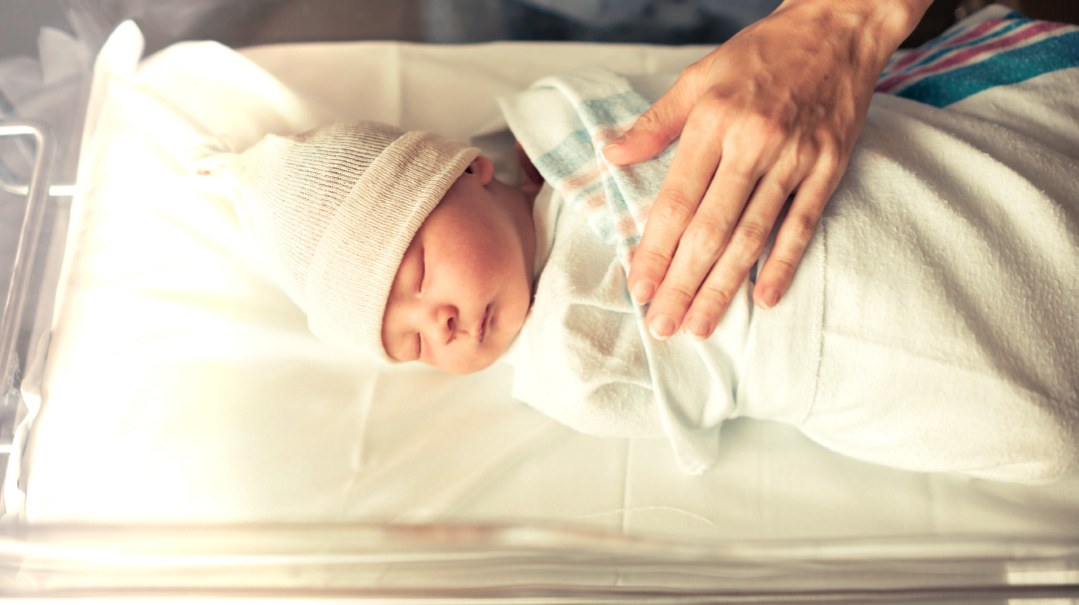Highly Sensitive
| March 26, 2024Was my body attacking my baby?

September 2010
“Squeeze your fist tightly,” the nurse said cheerily as she drew a few vials of blood. It was my first OB appointment ever, and we were thrilled, excited, a little nervous, all the good things.
Dr. Stein introduced herself to my husband and me, then gave us the usual rundown — no raw deli meat, no raw sushi, one cup of coffee, keep your tuna intake to a minimum, take your prenatals, see you in a month. Any questions? We didn’t — I had already bought the book and was reading ahead.
We walked out into the fall sunshine on a high.
October 2010
I sat on the edge of the exam table, the paper crinkling beneath me as I fidgeted. Dr Stein was sitting in her chair facing me, her voice calm.
“So everything is looking great,” she said to me, reviewing my sonogram. I held the edges of the black-and-white printout carefully and smiled back.
She glanced at my chart again. “By the way, the blood work we took last month showed that you have a negative blood type, the same as about 15 percent of the population.” She launched into a quick genetics lesson, but biology was my favorite subject in school, so I was interested.
“All babies have two Rh factor alleles — one from each of their parents. You’re negative, which means both your parents are negative, too. If your husband’s blood type is positive, there’s a 50-100 percent chance the baby’s blood will be positive, depending on if your husband has one positive allele or two, and because your body doesn't have Rh-positive blood, it will consider the baby’s Rh-positive blood to be a foreign substance. It sounds crazy, but it’s not that rare. When you’re 28 weeks you’ll need a shot called RhoGAM, which will cover you through the end of your pregnancy, and you’ll get another shot after delivery. RhoGAM will send an alert to your immune system to let it know not to create antibodies against your baby’s blood.”
Dr. Stein explained what a baby would go through during my future pregnancies if I didn’t get the shot. Basically, my body would treat a baby like a foreign substance that it had been vaccinated against, and my immune system would just do what it thought was best for me: attack the unfamiliar red bloods cells it encountered and break them down. Untreated, a baby could develop some severe complications that might not be compatible with life. She explained that before RhoGAM was invented in the 1960s, about 10,000 newborns a year died of Rh disease, and far more were born with debilitating brain damage. Obviously, we needed the RhoGAM.
I glanced at my husband to see if he was taking it in. He was never the science buff I was, but he was interested. Dr. Stein assured us that the bottom line was, modern medicine is a huge brachah, and this is not a big deal. Shot aside, it was shaping up to be a pretty straightforward pregnancy, baruch Hashem.
And it was. I went to the doctor for regular check-ins, I got the RhoGAM shot at 28 weeks; it wasn't mentioned again for the duration of my pregnancy. Five days after my due date, on a beautiful May Friday night, Dr. Stein handed me an adorable baby with a hearty mazel tov, and we were on cloud nine. Seventy-two hours later I got a second RhoGAM shot to boost the first one, to prevent antibodies from being developed after birth, and I took my little cutie home.
April 2012
Feeling a happy kind of déjà vu, I sat through another initial pregnancy appointment. My mother-in-law was watching Avi, and I glanced at my watch — it was almost time for his nap, and I hoped she remembered the schedule I’d told her. I focused on the doctor. It wasn’t my first rodeo anymore, and I nodded along this time when Dr. Stein gave me the no-sushi talk.
A week later, I dashed into Target for yet another diaper run, thinking about my near future of two in diapers. I pushed the cart past the clothes, eyeing a tiny floral newborn onesie that was definitely too early to buy, especially since I didn’t even know what I was having yet. My phone chimed, and Dr. Stein’s office popped up on my caller ID. I was surprised to hear the doctor herself on the line — usually it was a nurse with a perfunctory call that my blood work was fine. “Hi, Raizy, I just wanted to let you know that everything is okay, but your blood work came back showing that you have anti-D antibodies. What that means is the RhoGAM we gave you in your first pregnancy didn’t do its job.”
I didn’t reply. I could understand what she was saying, but it made no sense. I barely remembered the shots I’d gotten during my first pregnancy, they were such a non-event. My body was not supposed to develop antibodies against my baby! Had it? Why hadn’t it worked?
“Should I be worried?” I asked, finally.
The doctor was nice, and firm. “Don’t stress out about it,” she said. “Feel good, and we’ll discuss it at your next appointment. And stay off Google,” she added.
Okay, I said. Then I ran to Google.
May 2012
Isoimmunized, alloimmunized, HDFN, RH sensitized…. There are tons of names for what I had, as it turns out. I knew this because I had spent the month researching what might be going on, but I still wasn’t really sure what this meant my pregnancy would look like.
Dr. Stein spent a lot of time with us after the regular checkup. She explained that my body had built antibodies against my baby’s positive blood type, despite their administration of RhoGAM, which was supposed to be a cure-all. For this pregnancy, since it was only my second and symptoms start off mild, we could compartmentalize. How can we treat the Rh sensitivity for this pregnancy, and what should we do going forward?
At that point, she referred me to Dr. Rebarber, her colleague who was with a Maternal Fetal Medicine practice. Dr. Stein’s perspective was that she should continue to treat me, and the MFM practice will treat the baby, since the pregnancy wasn’t the issue — I didn’t need high-risk treatment, just the baby did. Practically speaking, that meant I needed to head into the city for monthly appointments with both doctors, but I scheduled them both for the same day each month and it was fine.
Dr. Stein asked us to go for more blood work to find out more details about my husband’s blood type, which we later found out was homozygous positive — which means my children will all be Rh-positive. (Possible intervention for Rh-sensitized people who are married to someone with a heterozygous positive would be to do IVF to guarantee Rh-negative babies.) Then she told me that whatever symptoms my baby might have will get progressively worse with each pregnancy.
I thought I knew what I was in for, but hearing the details laid out was pretty frightening. I was young, still practically a newlywed, and this was only our second child! I was totally freaked out. What if I couldn’t have more kids? What if this pregnancy would cause complications or brain damage, or chas v’shalom, something even worse? Who knew what would be?
My husband was as worried as I was. During the previous month’s research, I had explained to him a bit about what I was reading, but it hadn’t sounded so severe.
He wanted to run to rebbes to get brachos and eitzos; I wanted to deep dive into Google and talk to more doctors. We ended up doing both — his Rebbe gave him chizuk and a brachah, and I made an appointment with Dr. Rebarber.
Dr. Rebarber was more well-versed in Rh-sensitized pregnancies, although my complication wasn’t a common one, since usually the RhoGAM shot did the job. It hadn’t for me, and the birth of my oldest had triggered the antibody response in my blood. He assured me that although it’s rare, with a practitioner who knows how to treat it and siyata d’Shmaya, the outcomes could be excellent, and he had patients with Rh sensitivity and very large families.
He broke it down to a detailed but easy to understand situation.
First of all, since this was only my first pregnancy since the antibodies had been triggered, the baby would be okay, and the risk for this pregnancy would be low. That was reassuring to hear. The great news was that for all pregnancies, it was treatable and temporary. Any issues would eventually resolve with my baby’s birth, which was a huge brachah.
He took some more blood to test the antibody. 1:8 was considered dangerous, but my levels were only 1:4 — things were not horrible yet. At 1:8 a baby could develop fetal hydrops, an extremely severe and dangerous level of fluid in the tissues that could be fatal.
We continued to monitor every two weeks from 16 weeks on, taking titer levels and measuring the baby’s blood flow. Dr. Rebarber used an MCA doppler, a mid-cerebral artery doppler that checks the blood flow in the baby’s brain. Based on the gestational age of the baby and the rate of blood flow, they can determine how anemic the baby is. Hemolytic anemia isn’t like iron deficiency — it means there’s a shortage of red blood cells, which would be the case if my antibodies were attacking my baby’s red blood cells and breaking them down. Anemia would be the first concern, and if the anemia isn’t addressed it could balloon into much more. It takes about 45 minutes to get the exact spot of the artery on the doppler, take three to four images, compare them for accuracy and plug it into the formula. If the numbers were low, we’ll see you back here in two weeks. If the numbers were teetering on the safe edge, I’d come back to redo this whole process in two days. If numbers were high, we would need to schedule a transfusion within two days. On top of that, I was seeing Dr. Stein for regular checkups every month. Family members pitched in to watch my first baby, and I headed into the city every other week, wondering how on earth people would manage all this and a full-time job.
Baruch Hashem, things progressed smoothly. The baby’s numbers stayed out of the danger zone until 37 weeks, at which point the measurements are no longer reliable, and I was induced without needing intervention at all during the pregnancy.
“It’s a girl!” Dr. Stein announced, and the nurse handed me a tiny, dark-haired bundle. I was thrilled Avi had a sister, but even more relieved that the pregnancy essentially been normal, and had ended with everybody healthy. Baby Shira was tested immediately for bilirubin, the biproduct of the broken-down heme in her body, but you didn’t need tests to see her skin’s yellow tinge. She did have high levels, as expected, but intervention was easy — she was able to stay in my room with me, under lights, for the two days we were in the hospital, and she came home the same time that I did. We continued to monitor her bilirubin, but after a week, life was perfectly normal — as normal as it could be with a newborn and a toddler.
Spring 2016
Life was busy with two young kids, but we were thrilled to learn it would soon get busier. B’chasdei Hashem, my third pregnancy was easy also — very similar to my daughter’s. I was monitored every other week, and again, no intervention was needed. My son was born at 37 weeks, also with very high bilirubin, but he came home with me, and his bris was on time.
Spring 2021
It had been a few years since my youngest was born, so I wasn’t sure how things would go this time. My children were nine, seven and almost five, and we were so excited about our impending good news. Blood work before the pregnancy had shown antibodies that were too low to titer. Amazing, we thought. Great news. Things will go smoothly.
At my initial pregnancy blood work, however, antibodies had already shot up to 1:365. The numbers we had been looking for in my last two pregnancies were 1:8, maybe 1:16 would be allowed if no other signs of anemia were found. But 1:365? I felt like a grenade with a loose pin. What would happen, and when? Antibodies lie dormant — when there’s nothing for them to fight, they don’t show up in the blood, but it’s not an indication that they’re not there, and obviously, mine were ready for a battle.
“I don’t treat numbers, I treat patients,” Dr. Rebarber assured me. “Once the titer number is 1:16 or higher, the protocol is the same. We’ll see if the baby is in distress or at risk for needing extreme intervention and take it from there.”
We did the testing, and tried to stay calm. I had a few weeks of a breather, but I knew once we hit the 16-week mark, we were in for a closely monitored pregnancy. Little did I know.
Summer 2021
At 16 weeks, we started bimonthly MCA dopplers, which we’d done with my previous two pregnancies. But by my second MCA appointment two weeks later, Dr. Rebarber was already getting more serious. “Raizy, we need to be prepared with a treatment plan,” he told me in his usual calm and quiet tone. “To start with, we need to start checking you every week. And if things progress, we’ll move on to a treatment plan.” Being in that neither-here-nor-there state was beyond stressful. Something might happen, but maybe not? I was fine now, and I was feeling fine, so worrying about the what-ifs felt like I was assuming the worst would happen. I played with Avi, I cooked dinner, I pretended life was normal, because if I could squint a little and hope and daven, maybe it would be.
I hovered in the almost unsafe zone until the baby was 25 weeks, at which point the numbers were higher than the doctors liked. At that point, they did further testing to search for other signs of anemia, since sonogram is accurate but it’s never 100 percent. Baruch Hashem, they didn’t find signs of hydrops, but the only way to prevent it from developing was to give the baby an intra-utero blood transfusion.
Fall 2021
My baby’s first transfusion of six was Thanksgiving weekend, and Mount Sinai was a zoo. If I know what the plan is and what I need to do, I can ignore the what-ifs, so I focused on the schedule and logistics and powered through. I needed to be in by 6 a.m. for monitoring, so my husband and I were up at 4:30 a.m., negative Covid results in hand, and got admitted to triage to be monitored. After about an hour and a half they wheeled me into a room right next to the OR, just in case… but I couldn’t think about just in case of what. The blood pressure cuff was a good distraction — it squeezed tight as they drew blood from the baby’s umbilical cord to check the baby’s blood and see how anemic it actually was. The next step was to decide how they’re transfusing. The options were to transfuse new O-negative blood straight into the baby’s umbilical cord — this was preferred since the blood absorbs slowly and the “good” blood will last longer, and because you can avoid sticking a needle into the baby directly. Option two would be a direct transfusion into the baby through the intrahepatic vein, which is not ideal. There could be risk of over-transfusing, plus blindly sticking a needle in the baby’s body is a risk. They offered me an epidural and antianxiety medications, but I wanted to go straight home after with a clear head in time to do the supper-homework-bedtime shift, so I declined.
We started the first transfusion, but after an hour of trying to get the transfusion needle positioned properly, it was clear the umbilical route would not work. The actual transfusion isn’t a whole bag, it’s just a syringe, because the baby is tiny. Finally, once the needle was placed, the whole thing took three minutes.
I went back to be monitored. The baby’s heart rate wasn’t steady at the beginning because I was fasting because of the C-section risk (which, in deference to my stress levels, I had put out of my mind as much as possible), but as soon as I had juice, she was great.
After that I needed a new transfusion every two to three weeks. I had four altogether, until I delivered her. Once you need that first transfusion, things are officially high risk. I was at the doctor every few days for monitoring, for extra growth scans, MCA scans, or more steroids. I didn’t have time to get nervous, because I was in the doctor’s office being reassured multiple times a week, but it was so emotionally draining. I would come home from each trip to the city exhausted.
As she got bigger I could feel when it was time for a transfusion. I was extra-attuned this pregnancy, and I would feel the progression. The baby’s movements would be slow, then almost stop, and as soon as she got new blood she was kicking around, happy as a clam. I knew what would be coming, and I would get so stressed — figuring out who would handle the morning routine for my big kids when I needed to be at the hospital at the crack of dawn, and have backup in case things took longer than I’d hoped and I wouldn’t be home to take my Pre-1Aer off the bus at three. And what if the transfusions weren’t enough? What if we were waiting too long in between each one? It was clearer than ever to me that the “normal”-feeling pregnancies I’d had were a thing of the past.
December 2021
On the baby’s third transfusion, I was alone in the hospital. Well, sort of. Covid was still raging, so I was only allowed to bring my husband, but he was putting our three older kids on the bus, an arrangement that stressed me out less than figuring out crack-of-dawn childcare. The transfusion began, and as always, there was a full room. In-utero transfusions aren’t common, and the nurses clamored to be the ones to be able to assist. There were interns and other doctors, too, who came to watch the spectacle. The crowd and I watched the screen in a mix of horror and hysteria (on my part) as my baby grabbed the needle that was finally in the umbilical cord and pulled it out. Positioning at that point had already taken two hours, and she needed the transfusion, so they injected sedatives into my unborn baby to get her to stop moving, and successfully transfused her. The doctor handled it calmly, and the nurses and interns were so impressed that the energy in the room was quickly restored to high spirits, but I was numb. I couldn’t think about what had almost happened. That night, I was so emotionally drained I slept for 18 hours straight.
January 2022
By the fourth transfusion, it was clear that the larger the baby was, the less safe it would be to continue transfusing her. At that point, having a premature baby at 34 weeks was safer.
After the last three months of transfusions, I was relieved to move on to the next steps. Thirty-four weeks wasn’t that early, I reasoned, and I trusted my doctor, who was certain this would give us the healthiest outcomes. I walked into Mount Sinai early one freezing morning, and baruch Hashem, she was born later that day, at a healthy 6 lbs 3 oz. The nursery was closed because of Covid, so they brought her isolette into my room to treat her high bilirubin, which we’d expected.
She didn’t need the NICU but they were working with NICU timelines — she had to be under the UV light for two and a half hours and could be out for a half hour to be fed. The first night, I could barely hold her, so I spent the night with my eyes locked on her tiny face in a relieved new-mom haze, until I noticed her breathing seemed to be a little uneven. I called the nurses.
“She’s fine,” they assured me. “Get some sleep, Mom.”
The next morning, they did a car seat test, which is standard with any baby born under 37 weeks, to make sure she can breathe safely while in the semi-reclined car seat position. Within ten minutes, she failed. A few hours later, they did the second car seat test and she failed within a few minutes.
After that, they took her to the NICU for 24 hours — it’s a whole other world there, and I was totally not prepared. The whole team came to introduce themselves and gave me a welcome kit for her siblings. It felt like some weird fantasy camp experience, with art therapists and musical therapists and a whole song and dance. I thought about babies with far more severe problems than mine, and how their families must feel.
In the end, she only needed a short and baruch Hashem uneventful two-week stay until they were confident that her breathing was stable enough, and we were nothing close to the worst-case scenario. At the time it was so overwhelming, but it was the best reason to be there — baruch Hashem, it wasn’t so urgent.
During that time, she was undergoing regular blood tests — routine tests and more extensive genetic testing. Her blood tests showed all her blood was donor blood, but we didn’t realize that right away. Over time it was clear that her body had become reliant on the donor blood and hadn’t kicked up its own red blood cell production yet. Blood tests showed type of O-negative, which obviously made no sense — this whole story was hinged on her positive blood status!
We found the transfer of care from prenatal to neonatal to be very difficult. No one tells anyone anything, so we had to figure this all out on our own and relay it to the right doctors, who’d see her O-negative blood tests and remark that she had the best blood type. Knowing what I know now, I should have insisted on a hematology appointment in the hospital so I could understand what her risks were from a doctor who specializes in blood diseases and issues, after birth.
At that point, I started doing my own research. I found the Allo podcast, which was great, and joined the Antibodies in Pregnancy Facebook group (which was the Allo Hope Foundation’s support group. Allo is the leading organization for support for Rh sensitivity). I saw some common threads, which helped me ask the right questions and figure out, along with my pediatrician, which interventions and supplements were necessary. I found the online resources to be so helpful, especially because in real life, friends and family were not as clued in. Friends kept telling me to give her iron, which she didn’t need. They would gush how lucky I was that we had two weeks “off” while the baby was in the NICU — I was probably sleeping so well, right? I laughed extra hard at that one when my 12, 2, and 4 a.m. alarms went off so I could wake up to pump to establish a milk supply.
After two long weeks, we were discharged, with a smile, a wave, and a follow-up with your pediatrician.
I should have demanded a hematology consult, I should have considered that her red blood cell count wasn’t great — but I didn’t know what I didn’t know. I wasn’t told there could be a drop in her red blood cell count further as her body establishes its own blood supply, or to look out for anemia.
At her initial pediatrician’s appointment, they started tracking her red blood count, and asked me to do a weekly CBC until it was high enough. Rochela was the sweetest, most well-behaved baby, a gorgeous redhead who her siblings couldn’t get enough of. I wondered if her alabaster skin just fit with her light coloring, but when she was four weeks old, something felt off. She was sleeping a lot — which new mother would complain about that? But like, a lot a lot — I needed to wake her for every feeding. Was this a preemie thing? I snapped a picture of her cute sleeping face to send to my family, and I looked at it closely — in the photo it was undeniable, she was way too pale. We went back to the doctor just in case, and her RBC was four (normal numbers are around 12). My pediatrician sent us straight to the ER for a transfusion — and unlike the scheduled ones during my pregnancy, I was totally caught unawares. I frantically arranged childcare and dinner for my older kids who would be home in a few hours, and called my husband to meet me there. After eight hours in the ER, she got transfused and admitted. The next morning she was discharged with a detailed follow-up care plan, including instructions for a hematologist.
At that point, it could have been scary and overwhelming, but perversely, I felt much more confident. I finally knew what we were looking for, and I knew that it was not a wait-and-see situation. A couple of weeks later, I ran to a PA in the 18 minutes before Shabbos because she looked pale, and we were back at the doctor’s regularly, but at least I knew what was going on.
Eight weeks later she had another transfusion, which she slept through. At that point her body was finally making its own blood, so they only transfused the minimum. Two weeks later, her body kicked her RBC count into high gear, and the numbers continued to go up from there.
Present
My phone buzzes, and I check it to see videos from Rochela’s morah. She’s still wearing the birthday crown she had on this morning, and her little face is scrunched into her signature smile as the others in her class toddle around her, the other morahs prodding them into a rendition of the happy birthday song. She’s at the best age now — hysterically funny without trying, all of her siblings’ favorite, by far. Fine, yes, and toddlerishly terrible sometimes; she’s two now after all! Medically, after that last transfusion when she was three months old, things got normal. She continues to progress and has had no other health issues since then. This parshah has been relegated to her medical history, a story I sometimes think about when I kiss her rosy cheeks goodnight.
(Originally featured in Family First, Issue 887)
Oops! We could not locate your form.







